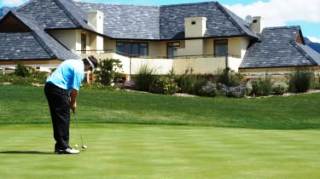|
Article Courtesy of Kiplinger Financial
By Eric Butterman
Published December 17, 2020
The dream of many retirees is a home in a golf course
community, where connecting a shiny driver with a perfectly dimpled ball on a
lush, green fairway is just another day in paradise.
But a golf club membership isn’t a given at these communities and sometimes
comes with hefty fees.
|
It pays to understand
just what exactly you’re getting. Some golf courses may be
owned by the community, while others may operate as an
entirely independent business. Because the attraction of
these communities is often tied to the golf club, make sure
your big green neighbor is financially healthy. If its
business suffers, so could your home values.
Golf club membership scenarios run the gamut, says Cathy
Harbin, president of OnCourse Operations, a golf management
company based in Paris, Tex. “It can be a developer owns the
club and pays your membership for you when you buy a home
lot or, through a promotion, they buy your initiation fee
and the first few years of your membership,” says Harbin, a
former vice president of golf for ClubCorp, which operates
private clubs. “Or it can even be an optional situation,
where you are offered a discount if you want to buy a
membership. Of course, it can just be you buy the home
separately, and the membership doesn’t have anything to do
with your purchase.” |
|
|
Generally, homeowners association fees and club costs are
higher for private clubs, says Harbin. At Desert Highlands, a private golf
course community in Scottsdale, Ariz., every homeowner must become a club
member, says Joan Sykora, director of sales and member relations. That
membership cost is a $75,000 initiation fee, and monthly HOA dues are $1,325.
At Ridgeview Ranch in Plano, Tex., where the community’s golf club is public,
members get unlimited range balls and discounts on rounds of golf at certain
hours—with the amount of times expanding depending on the monthly membership
fees, $49.95 or $69.95. There’s no initiation fee and the HOA fee is a
semiannual $254 with an extra $107 for one community neighborhood. On the
downside, crowded play is more likely at a public club, and the courses may not
be as challenging as a private club’s.
Still, membership fees may be the least of your problems if the golf club has
financial difficulties. When the Sanctuary Golf Club in Beaufort, S.C.,
shuttered its doors in January 2019 and went into foreclosure, homeowners in the
nearby Cat Island community had reason to fear the worst. Home values for
communities with shuttered golf clubs can fall by more than 20% in an average
economy, says Jeff Pinckney, a Beaufort-based part-time commercial realtor.
Cat Island residents were lucky because although the golf club was closed for
about a year, it eventually found a new buyer and has since partially reopened,
he says. As a result, home prices weren’t as affected.
Realtor Susan Akagi of Lakefront Living, On the Lake Realty, in Loudon, Tenn.,
says prospective buyers can get a better idea of how a community golf club is
doing by talking to the club’s chief financial officer. A golf course that’s
been around a long time often “gives a greater sense of stability,” she adds.
Plus, most communities also include other amenities for family members who don’t
play golf, which can help real estate values if something happens to the golf
club.
Are the communities worth it? To 60-something Janis Killion, they are, and she
isn’t even an avid golfer. She makes her home in the Pine Mountain Lake
community in Groveland, Calif., which along with a golf course also offers a
pool, tennis and pickleball courts, hiking trails and a private lake for boating
and fishing. A broker associate who sells real estate there and a former school
district assistant, Killion finds the community’s connection to nature fits her
personality.
“Our children love to play golf and it makes it even better when they come to
visit,” she says. “Even though I don’t play, I want to. And living in a golf
course community means it’s ready when I’m ready.” |
